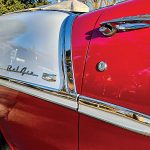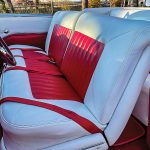When domestic auto makers returned to production after World War II, they mostly resumed assembling the same style cars, with only basic modifications, they were delivering before the war.
Then in 1955, Chevrolet transformed everything when the automobile company introduced the car that would be such a hit with consumers to require 1.7 million of them to meet the demand of enthused buyers across the country.
That was almost 600,000 more than the total Chevys produced in 1954 and a quarter million more than Ford’s production in 1955, making General Motors the most profitable and highly valued company in the world.
The new body style that was only slightly changed in the 1956 version, and again revised for the iconic 1957 model, today is known as the Tri Fives of automobile history.
They shared the culture’s stage with Elvis, Marilyn Monroe and “Leave it to Beaver.” A black ’55 Chevy was featured in that final drag race in the cult classic “American Graffiti” in 1973 with a young Harrison Ford at the wheel. It, unfortunately, was bested by the 1932 yellow Ford Deuce Coupe and wound up upside down in a ditch.
Arlington collector Bob Sherwood first encountered this magnificent top-of-the-line Bel Air convertible in 2008 at a car competition in Heritage Park, where it won the top prize as the best of that show.
That’s when he met its owner, Jimmy Lewis, and approached him with an offer to buy the highly collectible 53-year-old classic.
“He just laughed,” Bob recalls. “It was not for sale at any price.”
Lewis, who would go on to drive it for 44,000 miles and win multiple other shows, had acquired the car in 2005 out of an Arkansas museum and proceeded with a frame-off restoration and customization. That work included a new 383 stroker engine producing something like 430 horsepower capable of speeds beyond 100 miles per hour. It was transformed from its original Regal Turquoise to the Gypsy Red you see here. “No, I’ve not driven it that fast,” Bob admits, “but I have no doubt it’s capable of that.”
That’s quite a upgrade from what Chevrolet was offering in the car in 1955. While an 8-cylinder engine was available as an option, the car’s basic motor was a 215-cubic-inch with a 3-speed manual transmission but well received by Motor Trend magazine, which gave it top marks for handling.
Popular Mechanics added its review, reporting acceleration for the V-8 Bel Air with Powerglide as being 0-60 in 12.9 seconds and adding that they credited it with a comfortable ride and good visibility.
Other modifications include a 5-speed manual transmission, custom mag wheels, a Cobalt instrument cluster, new seats and carpet. Further upgrades to power steering, brakes, and air conditioning are included with the makeover.
Bob met his friend Nancy York at that 2008 car show when she was dating the late Jimmy Lewis. After his passing, his daughter did eventually decide to sell the Bel Air, and Bob was able to acquire it just six months ago.
“It stops traffic wherever we drive it, and we just love to hear the comments people make about it – especially from youngsters who confirm the great American love affair with automobiles continues with the new generation.”
The backdrop for this month’s feature is the historic Fielder House Museum – an appropriate location, seeing that Nancy served as the Arlington Historical Society’s president in 2006. Along with Geraldine Mills, the director of the museum, they formally transferred title of selected archival materials and photographs of Arlington’s history to the UTA Library’s Special Collections.
While Arlington’s history goes way back beyond 1955, the appearance of this classic Bel Air Chevy in its parking lot makes it seem right at home.
In conclusion, I have my own attachment to the ’55 Chevy. It was my first car. I purchased it in 1962 while in college. I paid $550 for it. I had no idea it would become the collectible it is today.
I wish I still had it.



















